Contec DS110-APL Spread spectrum transmitter User Manual FX DS110 APL
Contec Co., Ltd. Spread spectrum transmitter FX DS110 APL
Contec >
manual

FX-DS110-APL i
Copyright
Copyright 2001 CONTEC Co., LTD. ALL RIGHTS RESERVED
No part of this document may be copied or reproduced in any form
by any means without prior written consent of CONTEC Co., LTD.
CONTEC Co., LTD. makes no commitment to update or keep
current the information contained in this document.
The information in this document is subject to change without
notice.
All relevant issues have been considered in the preparation of this
document. Should you notice an omission or any questionable
item in this document, please feel free to notify
CONTEC Co., LTD.
Regardless of the foregoing statement, CONTEC assumes no
responsibility for any errors that may appear in this document nor
for results obtained by the user as a result of using this product.
Trademarks
MS, Microsoft, MS-DOS and Windows are trademarks of Microsoft
Corporation. Other brand and product names are trademarks of their
respective holder.

FX-DS110-APL
ii
Product Configuration
・ FX-DS110-APL …1
・ AC Adapter with 1.8m cable …1
・ Tapping screws (for mounting on wall, etc.) …2
・ Locking screw (for connecting to ground wire) …1
・ Magnets (for mounting on metallic surfaces) …2
・ Rubber feet …4
・ Floppy disk …1
・ User’s Manual (this booklet)…1
・ Installation Guide …1
User's Manual
FX-DS110-APL Floppy disk x 1
AC Adapter x 1
Installation
Guide
Tapping screw x 2
Rubber feet x 4
Locking screw x 1
User's Manual
Magnet x 2
POWER
WRX
WLINK
LIN K
RX
Check the contents to make sure that you have everything listed
above. If you do not have all the items, contact your distributor
or CONTEC group office where you purchased.

FX-DS110-APL iii
Table of Contents
Table of ContentsTable of Contents
Table of Contents
Copyright............................................................................i
Trademarks ........................................................................i
Product Configuration ..................................................... ii
1. Introduction
1. Introduction1. Introduction
1. Introduction................................
................................................................
.................................................
.
.................
.
.................
.
.................
.
Features ........................................................................1
Terminology/Abbreviations ..........................................2
Limited One-Year Warranty.........................................2
How to Obtain Service..................................................3
Liability.........................................................................3
Handling Precautions...................................................3
Precautions for Use ......................................................4
Precautions Related to Electromagnetic Interference4
Precautions Related to Service ....................................5
About the Manual.........................................................6
2. Overview
2. Overview2. Overview
2. Overview................................
................................................................
....................................................
.
....................
.
....................
.
....................
.
Component Locations .......................................................7
LED Indicators..................................................................8
DIP Switches.....................................................................9
Multi-channel Operation................................................10
3. Operating Mode Descriptions
3. Operating Mode Descriptions3. Operating Mode Descriptions
3. Operating Mode Descriptions................................
................................................................
.....................................
.
.....
.
.....
.
.....
.
ADHOC (Simple Mode)...................................................13
Infrastructure (Standard Mode) ....................................14
Operating Modes and Communications ........................15
4. Setup
4. Setup4. Setup
4. Setup ................................
................................................................
.......................................................
.
.......................
.
.......................
.
.......................
.
Wall Installation .............................................................17
Using the Mounting Screws (Included).....................17
Using the Magnets (Included)....................................18
Table Top Installation.....................................................20
Cable Installation ...........................................................20
Power Supply Connection...............................................21
Ground Connection.........................................................22

FX-DS110-APL
iv
5. Settings
5. Settings5. Settings
5. Settings................................
................................................................
......................................................
.
......................
.
......................
.
......................
.
Preparing the Utility Software ......................................23
Utility Software Settings................................................24
Edit Device Name.......................................................25
Configuration..............................................................26
Firmware.....................................................................27
Status ..........................................................................28
Setting Descriptions .......................................................29
Edit..............................................................................29
Base .............................................................................29
SNMP ..........................................................................32
Spanning Tree.............................................................33
Other Settings.............................................................35
To Register or Set Up a New Access Point.....................36
To Edit Settings for an Existing Access Point...............36
To Use Data scramble Functions for Better Security ...37
To Use SNMP Agent Functions......................................37
To Use Spanning Tree.....................................................38
To Access the APL from a Different Router...................38
6. Spanning Tree Algorithms (STA)
6. Spanning Tree Algorithms (STA)6. Spanning Tree Algorithms (STA)
6. Spanning Tree Algorithms (STA)................................
................................................................
..................................
....
..
3
33
3
What is an STA?..............................................................39
STA Parameters..............................................................40
Bridge Level................................................................40
Port Level....................................................................42
Sample STA Application.................................................43
7. SNMP Agent Functions
7. SNMP Agent Functions7. SNMP Agent Functions
7. SNMP Agent Functions................................
................................................................
.........................................
.
.........
.
.........
.
.........
.
SNMPc Overview............................................................47
MIB Support....................................................................48
Control Using SNMPc ....................................................49
Building-in to SNMPc.....................................................50
MIB Database Updates ..................................................50

FX-DS110-APL v
8. Troubleshooting
8. Troubleshooting8. Troubleshooting
8. Troubleshooting ................................
................................................................
...............................................
.
...............
.
...............
.
...............
.
When Communication Fails.......................................51
When SNMP Connections Fail...................................52
When the APL Will Not Start ....................................53
9. Appendix
9. Appendix9. Appendix
9. Appendix................................
................................................................
.....................................................
.
.....................
.
.....................
.
.....................
.
Product Specifications ....................................................55
Input/Output Interface...................................................57
UTP Port Pin Assignments ........................................57
Glossary...........................................................................58
10. Index
10. Index10. Index
10. Index................................
................................................................
.......................................................
.
.......................
.
.......................
.
.......................
.

FX-DS110-APL
vi
List of Figures
List of FiguresList of Figures
List of Figures
Figure 2.1. Component Locations.................................................7
Figure 2.2. Multi-channel Operation...........................................10
Figure 2.3. Channel Frequencies................................................. 11
Figure 3.1. ADHOC Mode..........................................................13
Figure 3.2. Infrastructure Mode ..................................................14
Figure 4.1. Wall Installation........................................................17
Figure 4.2. Attaching Magnets....................................................18
Figure 4.3. Removing Magnets...................................................18
Figure 4.4. Installation on a Steel Desk ......................................19
Figure 4.5. Cable Connection......................................................20
Figure 4.6. Power Supply Connection ........................................21
Figure 4.7. Ground Connection...................................................22
Figure 5.1. Main Menu................................................................24
Figure 5.2. Edit............................................................................25
Figure 5.3. Configuration............................................................26
Figure 5.4. Firmware...................................................................27
Figure 5.5. Status.........................................................................28
Figure 6.1. Sample STA Application ..........................................43
Figure 6.2. After STA Application..............................................44
Figure 6.3. Reconfigured After STA Application.......................45
Figure 7.1. Settings......................................................................49
Figure 9.1. External Dimensions.................................................56

FX-DS110-APL vii
List of Tables
List of TablesList of Tables
List of Tables
Table 2.1. ADHOC (Simple Mode) ...............................................8
Table 2.2. Infrastructure (Standard Mode) [Unit Type AP]...........8
Table 2.3. Infrastructure (Standard Mode) [Unit Type Station] ....8
Table 2.4. Other..............................................................................8
Table 2.5. DIP Switches .................................................................9
Table 3.1. Operating Modes and Communications......................15
Table 7.1. Group Names...............................................................48
Table 9.1. Physical Specifications................................................55
Table 9.2. Software Specifications...............................................55
Table 9.3. Installation Environment Conditions
(Environment Specifications)...................................55
Table 9.4. UTP Port Pin Assignments..........................................57

FX-DS110-APL
viii

Introduction
FX-DS110-APL 1
1. Introduction
Thank you for purchasing the FX-DS110-APL access point.
This product is a wireless LAN access point using the 2.4GHz
spectrum diffusion system, and is compatible with IEEE Standard
802.11b for wireless LAN.
The FX-DS110-APL is designed for use as an access point as well
as a station (Ethernet ⇔ wireless converter). It is independent of
operating systems or protocols, so that it can be connected by UTP
cable to any Ethernet-compatible desktop computer, workstation,
point-of-sale terminal, printer, etc. for immediate wireless LAN use.
This product can also enable wireless communications from any PC
previously unsuitable for wireless communications due to lack of a
PC card slot or expansion bus slot.
Of course the FX-DS110-APL also operates as an access point,
allowing the user to configure a small wireless LAN system using
the product by itself.
This document explains how to use the FX-DS110-APL. Be sure to
read it carefully so that you can use the product correctly.
Features
・ Ultra-compact antenna (micro access point)
Space-saving design allows installation anywhere (wall, magnet,
desktop)
・ Operates as a LAN station
・ Optional power supply from LAN cable
Uses compact, lightweight AC adapter.
・ Full range of functions (roaming, 13-channel support)
・ Automatic transmission speed (wireless) switching
Automatically switches transmission speeds from 11Mbps to
5.5Mbps, 2Mbps, 1Mbps according to conditions.
・ Built-in SNMP agent
Uses MNMP compatible software for easy network management.
・ Can be used with higher level model FX-DS110-APE.

Introduction
FX-DS110-APL
2
Terminology/Abbreviations
The following terms and abbreviations are used in this manual for
convenience.
FX-DS110-APL Access point/AP/APL
FX-DS110-PCC、FX-PCI-EXT2 User unit
or a PC containing the above
FX-DS110-APL Wireless terminal
or a device containing the above
Personal computer PC
Full term Term used in this manual
Limited One-Year Warranty
CONTEC Interface boards are warranted by CONTEC Co., LTD. to
be free from defects in material and workmanship for up to one year
from the date of purchase by the original purchaser.
Repair will be free of charge only when this device is returned
freight prepaid with a copy of the original invoice and a Return
Merchandise Authorization to the distributor or the CONTEC group
office, from which it was purchased.
This warranty is not applicable for scratches or normal wear, but
only for the electronic circuitry and original boards. The warranty
is not applicable if the device has been tampered with or damaged
through abuse, mistreatment, neglect, or unreasonable use, or if the
original invoice is not included, in which case repairs will be
considered beyond the warranty policy.

Introduction
FX-DS110-APL 3
How to Obtain Service
For replacement or repair, return the device freight prepaid, with a
copy of the original invoice. Please obtain a Return Merchandise
Authorization Number (RMA) from the CONTEC group office
where you purchased before returning any product.
* No product will be accepted by CONTEC group without the
RMA number.
Liability
The obligation of the warrantor is solely to repair or replace the product.
In no event will the warrantor be liable for any incidental or
consequential damages due to such defect or consequences that arise
from inexperienced usage, misuse, or malfunction of this device.
Handling Precautions
Take the following precautions when handling this board.
・ Do not attempt to modify this device. The manufacturer will
bear no responsibility whatsoever for the device if it has been
modified.
・ Do not store this device in high temperature or low temperature
surroundings, or expose it to rapid temperature changes.
(Operating temperature range: 0° to 50°C)
・ Do not use or store this device where it is exposed to direct
sunlight or near stoves or other sources of heat.
・ Do not use or store this device where it is exposed to dust or high
humidity.
(Operating humidity range: 0-95%, without condensation)
・ This product contains precision electronic elements and must not
be used in locations subject to physical shock or strong vibration.
・ Do not use or store this device near strong magnetic fields or
devices emitting electromagnetic radiation.
・ If abnormal smells or heat are noticed, disconnect the power
supply immediately.
・ In case of abnormal operation or failure, contact the store where
this product was purchased.

Introduction
FX-DS110-APL
4
Precautions Related to Electromagnetic Interference
This device complies with Part 15 of the FCC Rules. Operation is
subject to the following two conditions : (1) this device may not cause
harmful interference, and (2) this device must accept any interference
received, including interference that may cause undesired operation.
This equipment complies with part 15 of the FCC rules. Any changes of
modifications not expressly approved by the manufacturer could void
the user’s authority to operate the equipment.
CAUTION: To comply with FCC RF exposure compliance
requirements, a separation distance of at least 5 cm must be
maintained between this device and all persons.
Precautions Related to Service
Clean the FX-DS110-APL by wiping lightly with a soft cloth moistened
with water or a cleaning solution.
Take care to avoid the use of benzene, thinners or other volatile
solutions which may cause deformation or discoloration.
Notes!
・
The unauthorized reproduction of this document, in whole or in part, is
prohibited.
・
The specifications, designs, and other contents of this document are
subject to change without notice.
・
The contents of this document are believed to be accurate, however if
any discrepancies noted should be brought to the attention of the store
where this product was purchased.
・
Notwithstanding the foregoing, the manufacturer is unable to accept
any claims for losses or lost profits, etc. Resulting from the use of this
product.
・
MS, Microsoft, Windows, Windows NT, and MS-DOS are registered
trademarks or trademarks of Microsoft Corporation in the U.S.A. and
other countries.
Netscape Navigator is a registered trademark of Netscape
Communications.
Other names of companies and products used in this document
trademarks or registered trademarks of the related companies. This
document does not use the symbols ™ , ® , © etc.

Introduction
FX-DS110-APL 5
About the Manual
This manual consists of the following chapters:
Chapter 1 Introduction
Chapter 2 Overview
Chapter 3 Operating Modes
Chapter 4 Placement
Chapter 5 Setting Up
Chapter 6 Spanning Tree Algorithm
Chapter 7 SNMP Agent Functions
Chapter 8 Troubleshooting
Chapter 9 Appendix
Chapter 10 Index
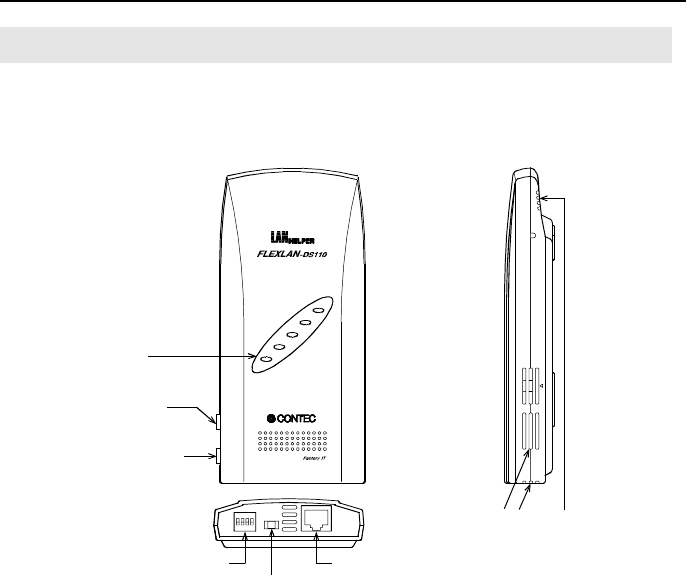
Overview
FX-DS110-APL
6
2. Overview
Component Locations
POWER
WRX
WLINK
LINK
RX
Front
DC/UTP UTP
Side
Ventilation Slits
DIP switches UTP connector
Power supply switch
Ground
terminal
Power
supply plug
LED
Caution Do not obstruct the ventilation slots.
This can cause heat buildup which can lead to damage or failure.
Figure 2.1. Component Locations
LED Indicators
The five LED indicators indicate the sending /receiving status of
the wireless or wired LAN, power supply, LAN connection status,
etc.
DIP Switches
The DIP switches are used for initialization, unit type selection, and
operating mode selection.
Power Supply Switch
Selects power supply from the AC adapter, or a UTP cable (requires
the POW-CB10, sold separately).

Overview
FX-DS110-APL 7
LED Indicators
Table 2.1. ADHOC (Simple Mode)
Flashing Startup, or startup error
On Operating
WLINK On Operating
WRX Flashing Receiving wireless LAN data
LINK On Wire LAN connection normal
RX Flashing Receiving wire LAN data
Name Status Indicator
POWER
Table 2.2. Infrastructure (Standard Mode) [Unit Type AP]
Flashing Startup, or startup error
On Operating
WLINK On Wireless LAN connection normal
WRX Flashing Receiving wireless LAN data
LINK On Wire LAN link connection normal
RX Flashing Receiving wire LAN data
POWER
Name Status Indicator
Table 2.3. Infrastructure (Standard Mode) [Unit Type Station]
Flashing Startup, or startup error
On Operating
WLINK On Wireless LAN connection normal
WRX Flashing Receiving wireless LAN data
LINK On Wire LAN link connection normal
RX Flashing Receiving wire LAN data
POWER
Name Status Indicator
Table 2.4. Other
Flashing 2 times Initialization error
Flashing 3 times Firmware writing error
POWER
WLINK
WRX
All flashing
at the same time Firmware writing in progress
Name Status Indicator
POWER

Overview
FX-DS110-APL
8
DIP Switches
The DIP switches are used to make AP settings.
The default setting for the utility software gives priority to the DIP
switch settings. The factory setting for all DIP switches is OFF.
At the factory, the unit is set to Ad Hoc Mode. The unit can be
used with the factory settings, by setting only the DIP switches.
However, security is not assured.
Table 2.5. DIP Switches
Used to initialize APs.
When this switch is turned on, the POWER, WLNK, and
WRX LED will start flashing.
If this switch is turned off while the LED's are flashing
(about 3 seconds, then all AP settings will be restored to default
values after the next startup.)
If this switch is on, the AP can operate without an IP address.
However the utility software cannot use the SNMP agent functions.
This switch sets the unit type.
It is valid when operating in infrastructure (standard mode).
AP… Controls APs used on other user units or STs.
ST… Treated as a user unit (controlled by (logged in) AP).
This switch sets the mode.
INFRA… Selects infrastructure (standard mode).
All wireless terminals communicate through unit type AP.
ADHOC… Selects ADHOC (simple mode).
All terminal are paired, communicate only as paired units.
All switches are set to OFF at factory.
OFF
ADHOC
DescriptionON
4
3AP
2IP
LESS _
ST
_INIT1
INFRA

Overview
FX-DS110-APL 9
Multi-channel Operation
By changing channels on adjacent access points, it is possible to
obtain higher throughput per wireless terminal than when is
channels are not changed, even when the number of wireless
terminals is increased.
The 2.4G band (2400 to 2483.5 MHz) in which this product
operates is subdivided into 13 channels, numbered 1 to 13, by IEEE
standard 802.11. Because each frequency has sidebands around its
central frequency, sidebands on adjacent channels overlap.
Overlapping frequencies can adversely affect communications by
interference with each other's transmissions.
Refer to Figure 2.3 when selecting channels, to ensure that
frequency bands do not overlap.
The maximum number of channels that can be used simultaneously
without interference is four, by using a combination of channels 1,
6, and 11. Channel numbers can be set from 1 to 13 using utility
software.
Two wireless terminals on the same network cannot use the same
frequency.
Network
AP1
POWER
WRX
WLINK
LINK
RX
AP2
POWER
WRX
WLINK
LINK
RX
POWER
WRX
WLINK
LINK
RX
POWER
WRX
WLINK
LINK
RX
POWER
WRX
WLINK
LINK
RX
POWER
WRX
WLINK
LINK
RX
Channel 1 Channel 6
POWER
WRX
WLINK
LINK
RX
POW ER
WRX
WLINK
LINK
RX
Figure 2.2. Multi-channel Operation
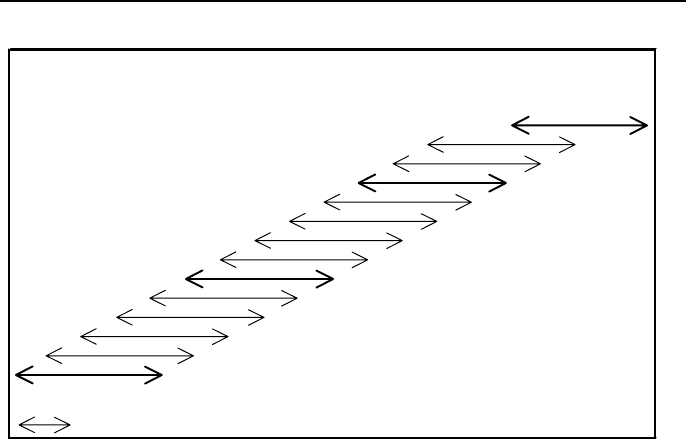
Overview
FX-DS110-APL
10
:Sideband frequency range for each channel
1 2 3 4 5 6 7 8 910111213 14
2412 2417 2422 24372427 2432 2442 2447 2452 2457 2462 2467 2472 2484
Center frequency
(MHz)
Channel
(14)
(1)
(4)
(3)
(5) (6)
(2)
(7) (8) (9) (10) (11) (12) (13)
Figure 2.3. Channel Frequencies

Overview
FX-DS110-APL 11
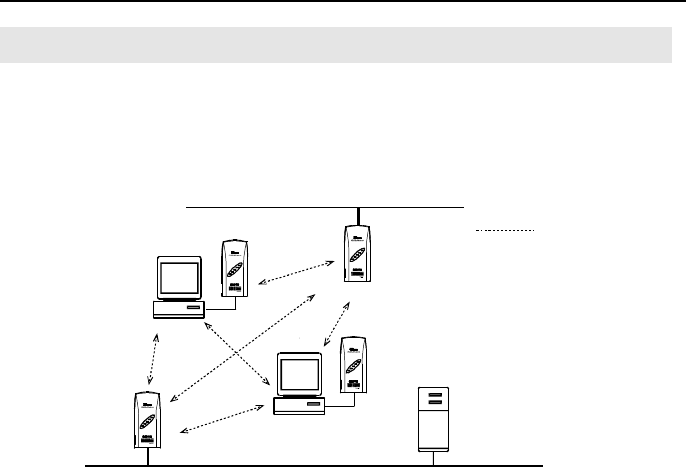
Operating Mode Descriptions
FX-DS110-APL
12
3. Operating Mode Descriptions
ADHOC (Simple Mode)
The following example shows a relatively small network configured
using ADHOC mode.
AH1
AH3
AH2
AH4
FS
Network A
Network B
POWER
WRX
WLINK
LINK
RX
AH : Devices in ADHOC connection
FS : File server
: Wireless connection
POWER
WRX
WLINK
LINK
RX
POWER
WRX
WLINK
LINK
RX
POWER
WRX
WLINK
LINK
RX
Figure 3.1. ADHOC Mode
In ADHOC (simple mode), all wireless devices are paired, and can
use wireless communication with the other device in the pair.
Lines can be duplicated using a spanning tree if bridges are
constructed using AP connections.
・ Advantages
(1) Requires virtually no setup work to start.
(2) Can bridge multiple wired LAN's, allows duplication of lines.
・ Disadvantages
(1) When the AP is a relay point the available communication
range is narrower than in infrastructure mode.
(2) Not suited to construction of large wireless LAN environments.
Note! When configuring a wireless LAN in simple (ADHOC) mode, be
sure to place all wireless terminals within effective communication
range. If units are too far apart, communications can be hindered
by partitions or other obstacles causing some terminals to be
unreachable and reducing system throughput.
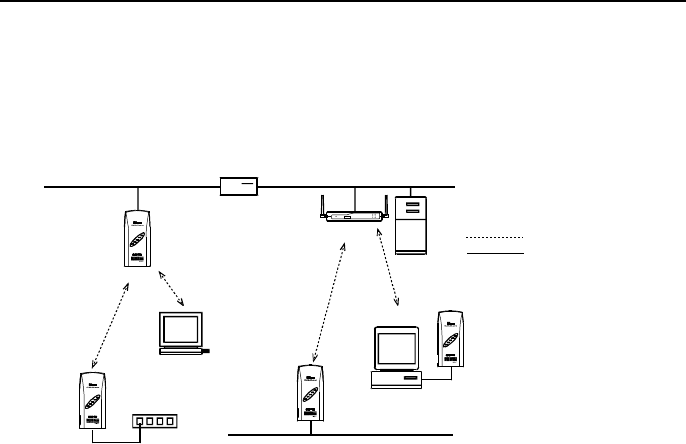
Operating Mode Descriptions
FX-DS110-APL 13
Infrastructure (Standard Mode)
This mode allows the use of multiple AP's to configure wide-area
wireless LAN's. All communication between wireless terminals
must go through an AP.
Network A Network B
Network C
AP1
AP2
U1
ST1
ST2
Note : An AP operating as a station has the same status as a user unit, as an AP managed by
(logged in with) an AP.
HUB ST3
Router
FS
10/100M
WTX/WR X
MGMT
POWER WLINK
ON
OFF
LINK/ACT
FDX/COL
1 MO DE M/ TE RM IN AL
2 RS SI
3 CH AN NE L1
4 CH AN NE L2
5 IN IT
AP : Unit type AP
U : User unit
FS : File server
ST : Unit type station
: Wireless connection
: Wired connection
POWER
WRX
WLINK
LINK
RX
POWER
WRX
WLINK
LINK
RX
POWER
WRX
WLINK
LINK
RX
POWER
WRX
WLINK
LINK
RX
Figure 3.2. Infrastructure Mode
In Infrastructure (standard mode) as shown above, all wireless
terminals communicate through unit type AP's. Roaming
functions are supported, allowing log-in on any unit type AP.
・ Advantages
(1) Allows multiple AP's to be set up to configure wide-are
wireless LAN's.
(2) Allows log-in restrictions on unit type AP's (security function).
・ Disadvantages
(1) All AP's must be IP controlled, requiring many settings.
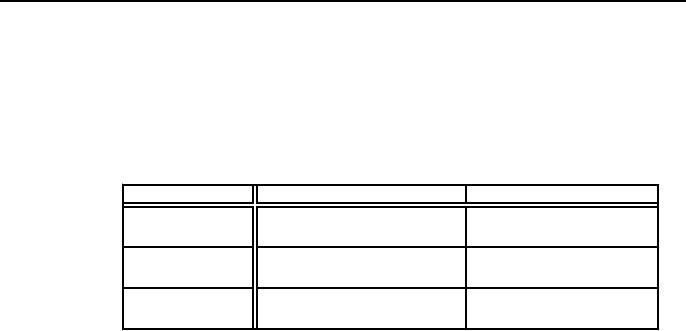
Operating Mode Descriptions
FX-DS110-APL
14
Operating Modes and Communications
The following operating modes allow communications with APL
and other FLEXLAN products.
Table 3.1. Operating Modes and Communications
FX-DS110-APL FX-DS110-PCC FX-DS110-APE
ADHOC ADHOC
(Simple Mode) (Simple Mode)
Infrastructure Infrastructure
(Standard Mode) (Standard Mode, Brouter Mode)
Infrastructure Compatible Infrastructure
(Compatible Mode) (Standard Mode, Brouter Mode)
Simple Mode
Standard Mode, Brouter Mode
Connection not possible

Operating Mode Descriptions
FX-DS110-APL 15
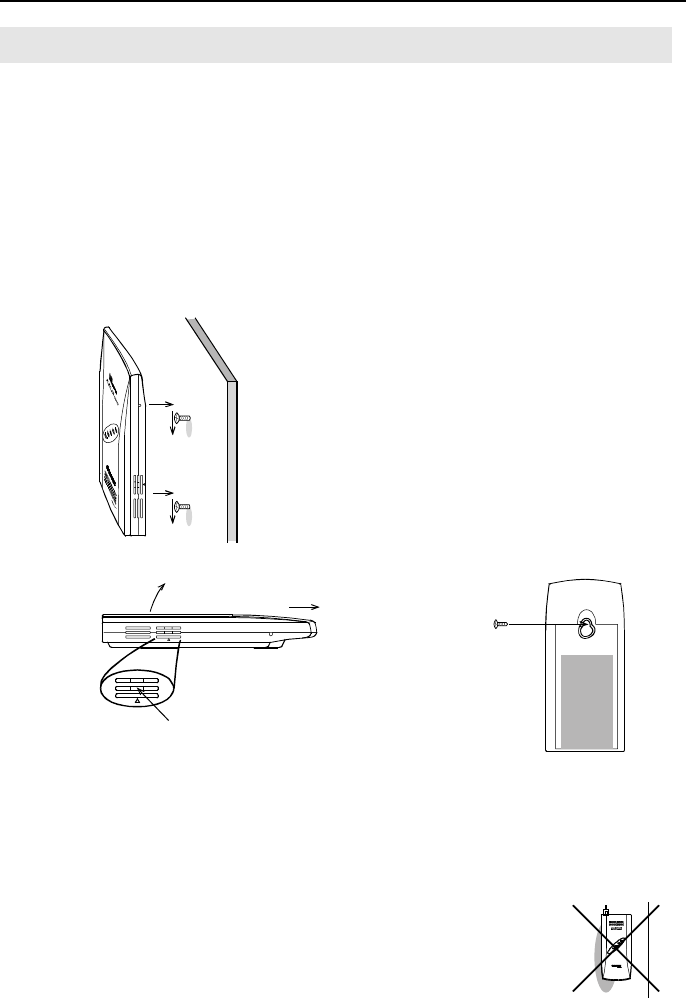
Setup
FX-DS110-APL
16
4. Setup
Wall Installation
Using the Mounting Screws (Included)
Place the screws in the wall according to the mounting diagram,
then mount the unit.
It is also possible to remove the cover from the unit, then remove
the wireless card and screw the unit onto the wall directly.
Diagram 1
(1) Place the screws in the wall according to the mounting diagram
(2 screws).
(2) Position the AP unit so that the two wall mount holes in the AP unit
fit over the two screws in the wall.
(3) Slide the AP unit down to hold it in place.
(1) Press here to open the lid.
(2) Slide the cover in the direction shown and release the
catch. Remove the wireless card.
(3) Insert the screw to attach the unit. After mounting,
replace the wireless card and cover.
(1)
(2)
(3)
(3)
Diagram 2
(1)
(1) (2)
Figure 4.1. Wall Installation
Note! Do not obstruct the ventilation slits. This can cause the
temperature inside the product to rise and can damage the
components inside.
Caution!
Do not install this unit upside down. This will
cause heat to accumulate and possible cause fire.
POWER
WRX
WLINK
LINK
RX
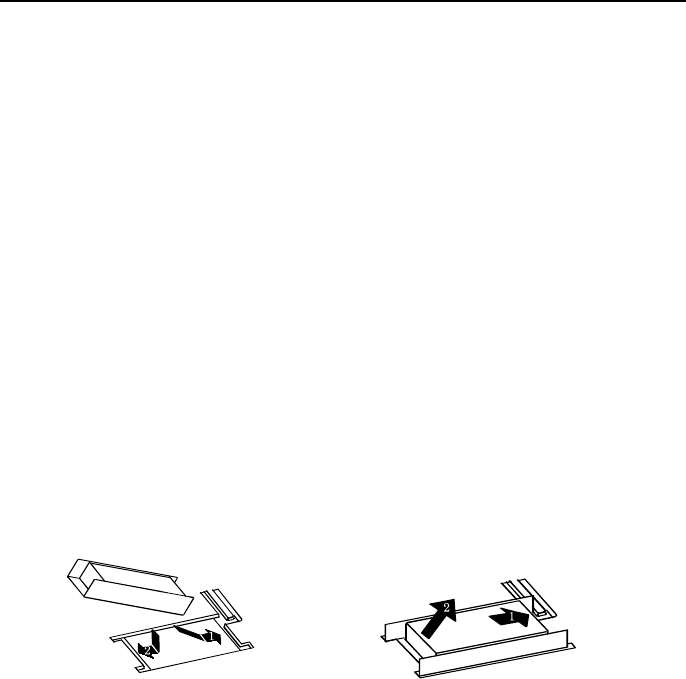
Setup
FX-DS110-APL 17
Using the Magnets (Included)
The magnets included with this product can be used for easy
mounting and removal on steel desks, partitions, or other metal
surfaces.
Notes!
・
Do not place magnets near monitors, floppy disks, or other
sensitive objects.
・
Moving the AP while it is mounted on a steel desk or similar
surface can cause paint scratching.
Attaching and Removing Magnets
To mount the unit using a magnet, push the magnet into the magnet
mounting hole in the direction of arrow 1 as shown in Figure 4.2. ,
then insert the entire magnet into the mounting hole.
Next, slide the magnet in the direction of arrow 2 to hold the unit in
place.
To remove, slide the magnet in the direction of arrow 1 in Figure
4.3. , then lift in the direction of arrow 2.
Magnet
Magnet mounting holes
Figure 4.2. Attaching Magnets Figure 4.3. Removing Magnets
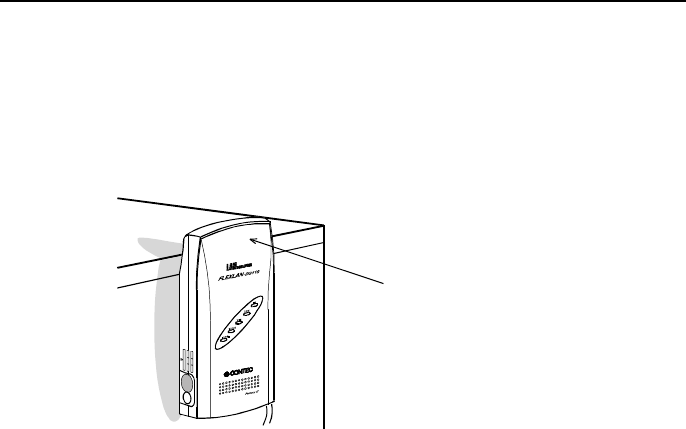
Setup
FX-DS110-APL
18
Mounting on Steel Desks or Partitions
The unit can be mounted directly on steel desks or partitions. Pull
lightly to make sure that the AP does not come off easily.
For better receiving sensitivity, mount the antenna against the steel
surface.
Antenna area
Figure 4.4. Installation on a Steel Desk
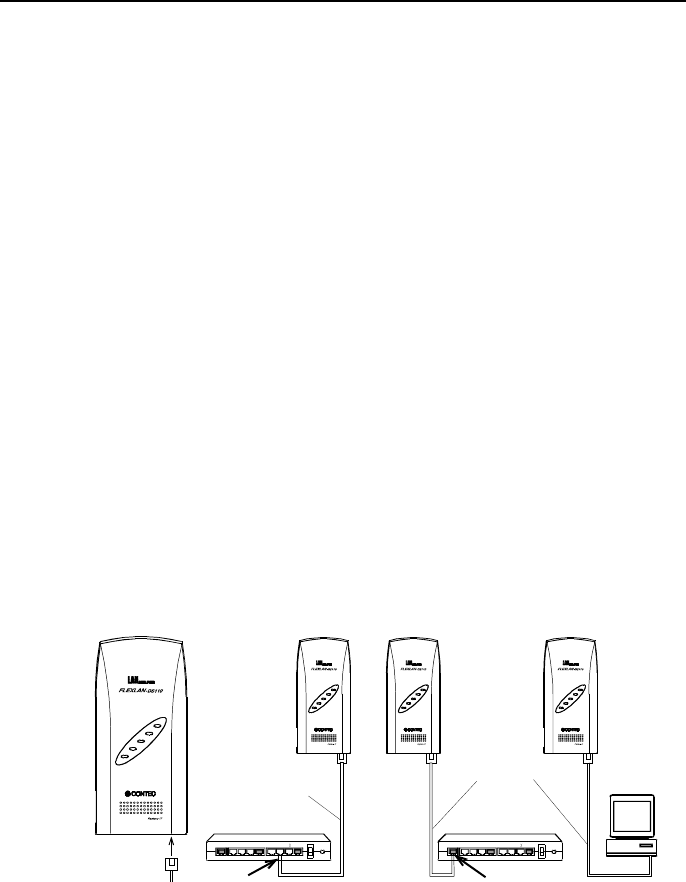
Setup
FX-DS110-APL 19
Table Top Installation
Use the rubber pads included with the unit.
To install on a table top, choose a sturdy, level surface with a
well-ventilated space (approx. 5 cm.) in all directions. Wireless
equipment has a larger sending and receiving range when it is in a
highly visible location. Choose a location where the sight lines
are as clear as possible.
Note! Do not obstruct the ventilation slits. This can cause the
temperature inside the product to rise and can damage the
components inside.
Cable Installation
Connect the UTP connector to the UTP cable.
Notes! ・ When connecting this product to a personal computer or hub use
a twisted pair cable no more than 100m in length.
・ Use UTP cable having category 3, 4, or 5 specifications. (If using
a 10BASE-T power supply, use a UTP cable with category 5
specifications.)
・ When connecting with a personal computer (NIC) or hub up-link
port, use a UTP cross cable (TP-X).
・ When connecting with a hub (other than up-link port), use a UTP
straight cable.
POWER
WRX
WLINK
LINK
RX
POWER
WRX
WLINK
LINK
RX
*1 Operates with the separately available cables TP-03 (3m), TP-05 (5m), TP-10 (10m), TP-20 (20m),
TP-50 (50m), TP-100 (100m)
*2 Operates with the separately available TP-X (30cm cross cable and attachment)
Note : The cable length between the unit and PC or hub should not exceed 100m.
POWER
WRX
WLINK
LINK
RX
PC (NIC)
HUB
UPL INK 8X 7X 6 X 5X 4X 3X 2X 1X
Cross cable *2
Up-Link port
Normal port (not Up-Link port)
POWER
WRX
WLINK
LIN K
RX
HUB
UPLI NK 8X 7X 6 X 5X 4X 3X 2X 1X
Straight cable *1
Figure 4.5. Cable Connection
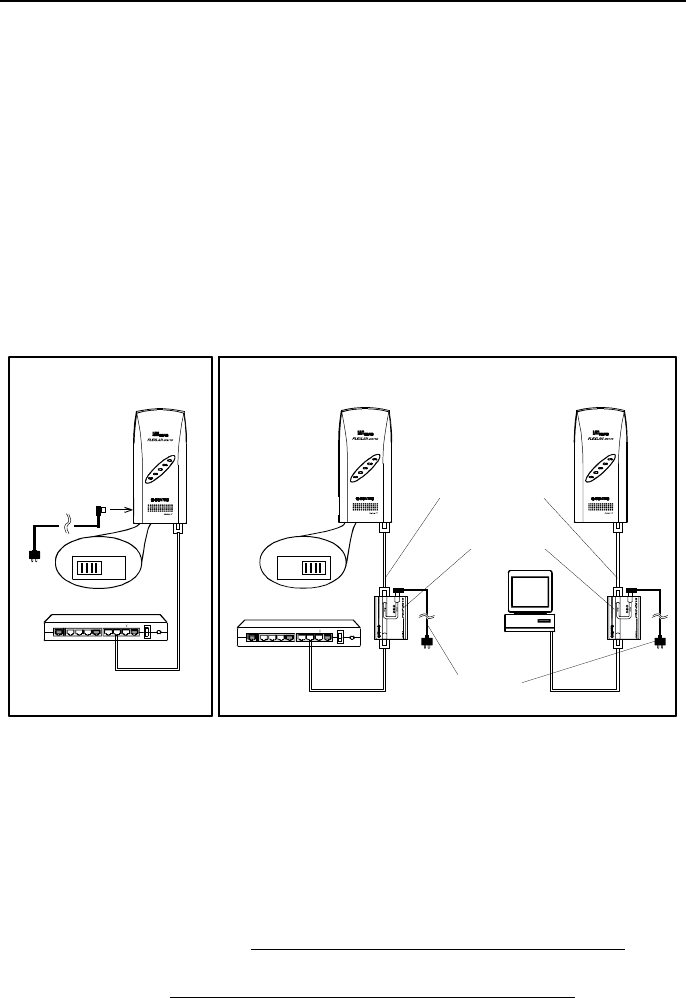
Setup
FX-DS110-APL
20
Power Supply Connection
There are two ways to connect the APL power supply.
Using the AC adapter provided with the unit
Connect the power adapter to a power outlet, and set the power
switch to 'DC.'
Using a UTP cable (requires the POW-CB10, sold separately)
To receive power from the UTP, set the power switch to 'UTP.'
The cable between the FX-DS110-APL and POW-CB10 should be
a UTP cable with category 5 specifications (maximum 30m).
Using the AC adapter (included)
POWER
WRX
WLINK
LINK
RX
Using a UTP cable
POWER
WRX
WLIN K
LINK
RX
POWER
WRX
WLINK
LINK
RX
HUB
Cross cable *2
Straight cable *1
(max. 30m)
AC adapter
HUB
DC/UTP DC/UTP
PC (NIC)
*1 Operates with the separately available cables TP-03 (3m), TP-05 (5m), TP-10 (10m), TP-20 (20m), TP-50 (50m).
*2 Operates with the separately available TP-X (30cm cross cable and attachment)
Note : The cable length between the unit and PC or hub should not exceed 90m.
UP LINK 8X 7X 6X 5X 4X 3X 2X 1X
Straight cable *1
Straight cable *1
POW-CB10
IN Data OUT
IN
AC adapter
UP LINK 8 X 7 X 6X 5X 4X 3X 2X 1X
IN Data OUT
IN
Figure 4.6. Power Supply Connection
Notes! Never use any AC adapter other then listed below. Unauthorized
adapters may cause damage or accidents due to overheating.
・
If the cable length between APL and POW-CB10 is between 10
and 30m, use the AC adapter supplied with the POW-CB10.
・
If the cable length between APL and POW-CB10 is 10m or less,
use the AC adapter supplied with the FX-DS110-APL.
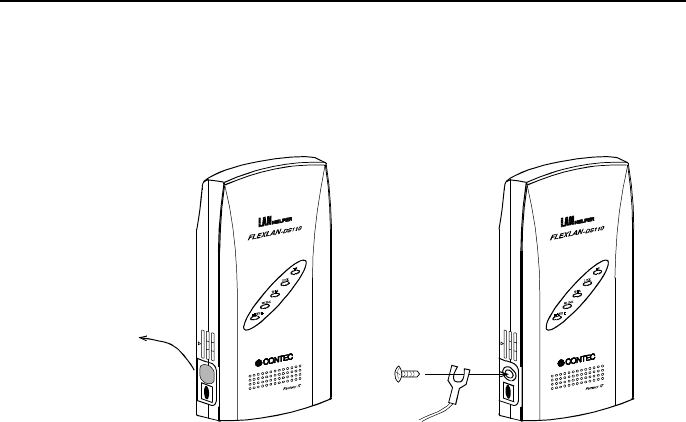
Setup
FX-DS110-APL 21
Ground Connection
Remove the rubber cover from the ground terminal, and connect the
ground wire using the locking screws (included).
Remove rubber cover
Figure 4.7. Ground Connection
Note! In some installation environments, the ground terminal may become
hot.

Settings
FX-DS110-APL
22
5. Settings
The utility software settings require the use of one personal
computer.
Preparing the Utility Software
(1) Insert the floppy disk (provided) in the A: drive of the
computer.
(2) Open the Explorer.
(3) Use Explorer to copy the file 'APUTIL.EXE' from the floppy
disk to the appropriate directory.
Example: C:/WLANUTIL/
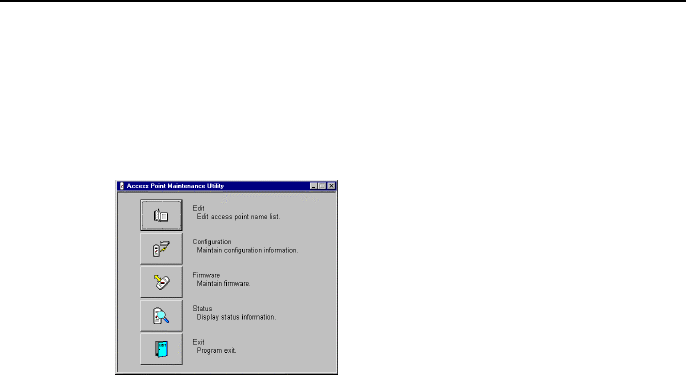
Settings
FX-DS110-APL 23
Utility Software Settings
Double click on the APUTIL.EXE file to open the Access Point
Maintenance Utility.
You will see the following main menu.
Figure 5.1. Main Menu
Edit
Edits the access point name list.
This list is used to detect devices connected by wired or wireless
connection. Device names are added or deleted using the edit
function.
Configuration
Maintains configuration information.
View or enter settings for the selected devices.
Firmware
Used for firmware maintenance.
View firmware version, or write firmware.
Status
Displays access point information.
View and verify information about the selected device.
Exit
Exits the program.
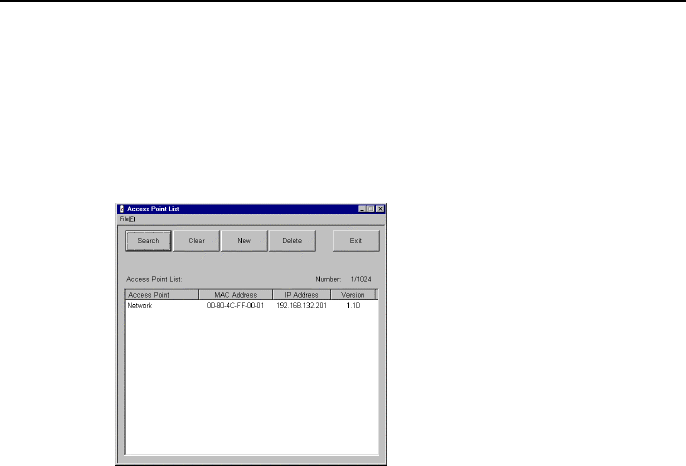
Settings
FX-DS110-APL
24
Edit Device Name
On the main menu, click the [Edit] key to open the following dialog
box. You can use the [Search] key to detect FX-DS110-APL
devices connected in wired or wireless connections. Double click
on a detected device to enter the appropriate device name. Click
the [Exit] key to return to the main menu.
Figure 5.2. Edit
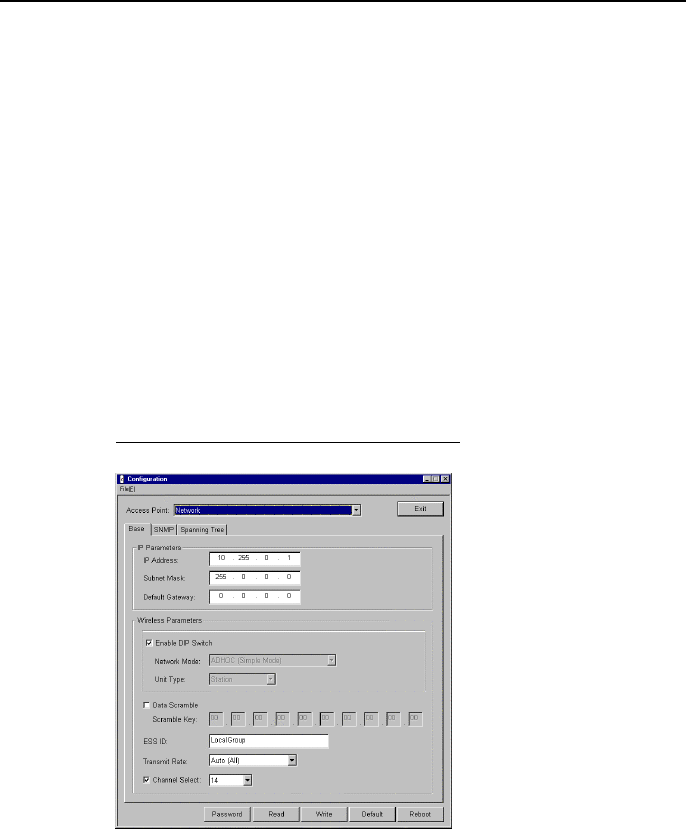
Settings
FX-DS110-APL 25
Configuration
On the main menu, click the [Configuration] key to open the
following dialog box. This allows you to view or enter settings for
the selected device. The dialog box contains IP parameter settings
including IP address, subnet mask, etc., wireless parameter settings
including operating mode, unit type, ESS ID, etc., as well as SNMP
and spanning tree settings.
The Base tab has settings shared by all operating modes. These
settings are required. The SNMP tab has settings that are needed
when using SNMP agent functions.
The Spanning Tree tab is valid only when the Network Mode
setting is 'ADHOC (Simple Mode)' in the Base tab.
Click the [Exit] key to return to the main menu.
To enable the APL setting, reboot the unit.
Figure 5.3. Configuration
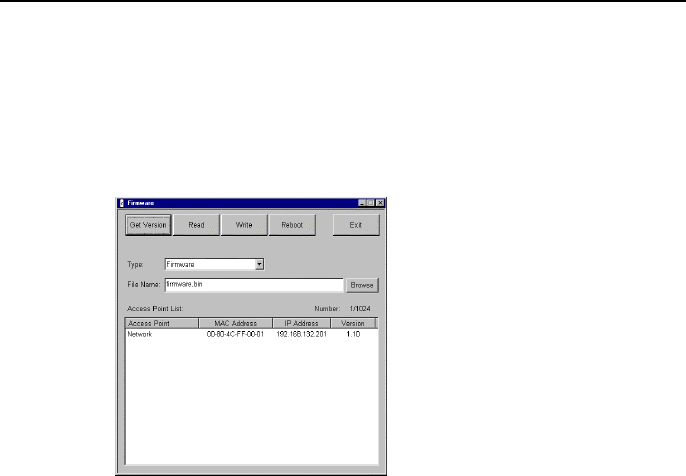
Settings
FX-DS110-APL
26
Firmware
On the main menu, click the [Firmware] key to open the following
dialog box. This screen lets you view firmware version
information, and write firmware. Click the [Exit] key to return to
the main menu.
Figure 5.4. Firmware
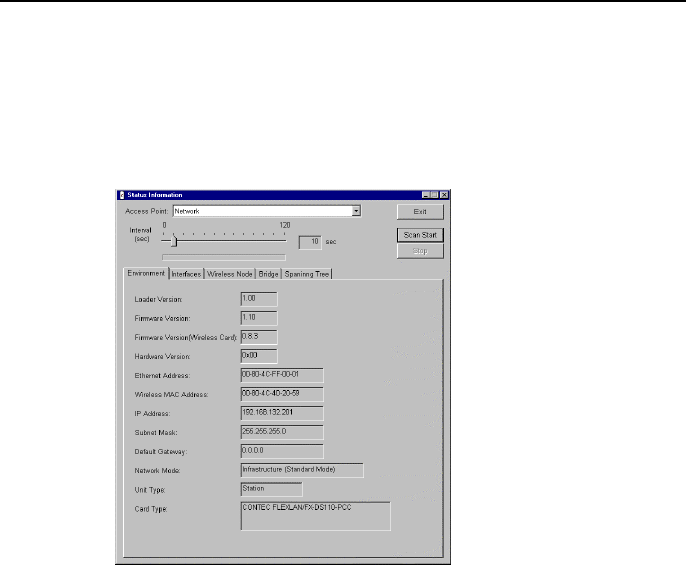
Settings
FX-DS110-APL 27
Status
On the main menu, click the [Status] key to open the following
dialog box. This screen lets you view status information about the
FX-DS110-APL device. Click the [Exit] key to return to the main
menu.
Figure 5.5. Status

Settings
FX-DS110-APL
28
Setting Descriptions
Edit
Access Point
Giving a name to an access point makes it easier to identify on the
network.
Names may be up to 32 characters. A maximum of 1024 names
may be entered.
Base
IP Address
Enter the IP address of the home station. This is written on the
seal on the bottom of each unit at the factory. This setting is not
necessary to use the APL as a wireless device, but if it is used in
combination with APE, or if the APL is accessed through different
routers, the IP address must be entered.
Factory setting: A unique value is assigned using the lower 3 bytes
of the 6-byte APL Ethernet address.
(Example) Ethernet address IP address
[00-80-4C-01-02-03] →[10.1.2.3]
[00-80-4C-0D-0E-0F] →[10.13.14.15]
The initial '10' is common to all settings.
Subnet Mask
If a subnet is used, enter the subnet mask number.
Factory setting: [255.0.0.0]
Default Gateway
This setting determines the IP address of the network router to
which this unit belongs.
Factory setting: [0.0.0.0]

Settings
FX-DS110-APL 29
Enable DIP Switch
If this box is checked, the DIP switch settings on this unit (mode
and unit type) are enabled.
Factory setting: Checked (DIP switches enabled)
・ Network Mode
Determines the operating mode of this unit. This setting is not
available if 'Enable DIP Switch' is checked.
Factory setting: Setting not available (DIP switch setting enabled).
・ Unit Type
This setting determines whether the unit operates as an access point
or station. In access point (AP) mode, this unit controls other user
units or access points operating in station mode. In station mode,
this unit is controlled by (logged in to) another AP.
Factory setting: Setting not available (DIP switch setting enabled).
Data Scramble
This setting determines whether wireless data is scrambled. Note
that it is not possible to communicate between a terminal with data
scramble enabled and a terminal with data scramble disabled, or
between two terminals with data scramble enabled but using
different scramble keys.
Factory setting: Not checked (data scramble off).
・ Scramble Key
Used for scrambling of wireless data.
Factory setting: [00.00.00.00.00.00.00.00.00.00]
Input values: Hexadecimal values (0-9, A-F).

Settings
FX-DS110-APL
30
ESS ID
This setting sets the name of the LAN network to which the unit
belongs.
Communication is not possible between two terminals having
different ESS ID settings. Conversely, a network can be
partitioned by using different ESS ID names.
Factory setting: 'LocalGroup'
Input values: Up to 32 alphabetic characters, case sensitive.
Transmit Rate
This setting determines the transmission rate of the sending side of
the unit for wireless transmissions. If the network mode setting is
'Infrastructure (Standard Mode)' and 'Station' mode, the unit can
automatically connect to all channels.
Factory setting: 'Auto(All)'
Input values: Selections: '1Mbps', '2Mbps', '1M/2Mbps',
'5.5Mbps', '11Mbps', 'Auto(All)'.
Channel Select
This setting selects the channel number.
Factory setting: Checked, channel 1.
Input values: Channel 1 to 13.

Settings
FX-DS110-APL 31
SNMP
Community Name
This is an SNMP recognizable character string, which functions
like a password for access to the access point from an SNMP.
Programs can access the access point MIB by using this community
name.
Factory setting: [public]
Input values: Up to 31 alphabetic characters, case sensitive.
Access
This setting determines the access authority for the community.
The selection is between 'Read Only' access or 'Read & Write'
access.
Factory setting: [Read & Write]
Send Trap
This setting determines whether the SNMP agent system will notify
the user of errors such as access right errors, or APL startup.
Factory setting: Unchecked (Do not send trap).
・ IP Address: Enter the IP address of the user to which the trap
is to be sent.
Name
This setting determines the name of this access point on the SNMP.
Factory setting: No setting entered
Input values: Maximum 31 characters
Location
This setting records the physical location of the access point, such
as "8F R&D Department."
Factory setting: No setting entered
Input values: Maximum 31 characters

Settings
FX-DS110-APL
32
Contact
This setting records contact information for the manager of this access
point, such as the network manager's name or telephone number.
Factory setting: No setting entered
Input values: Maximum 31 characters
Spanning Tree
Enable Spanning Tree
This setting determines whether the spanning tree function is used. It is
valid only when the network mode is 'ADHOC (Simple Mode).'
Factory setting: Checked (Use)
Bridge Priority
The lower the value of this setting, the higher the priority of this access
point in the spanning tree. Changing this priority will change the root
bridge of all bridges in the network.
Factory setting: 32768
Input values: 0 to 65535
BPDU (Bridge Protocol Data Unit) Max Age Time
The BPDU max age time determines the maximum length of time
that this access point can be used before the information obtained from
the BPDU is discarded.
Factory setting: 20 seconds
Input values: 6 to 40 seconds
BPDU (Bridge Protocol Data Unit) Hello Time
The BPDU hello time determines the interval over which the BPDU
transmits when it is the root, or attempting to be the root, of this access
point.
Factory setting: 2 seconds
Input values: 1 to 10 seconds

Settings
FX-DS110-APL 33
Forward Delay
This setting determines the delay time between a blocking condition and
transition to forwarding operation.
Factory setting: 15 seconds
Input values: 4 to 30 seconds
Path Cost
This setting determines the cost allocated to this AP's wired (Ethernet)
port or wireless port. The lower the cost allocated to the port, the higher
the probability that that port will be accessed. The following setting
values are recommended under IEEE 802.1D.
COST=1000/Attached LAN Speed in Mbps
Factory setting: Ethernet port… 100, wireless port… 500
Input values: 1 to 65535

Settings
FX-DS110-APL
34
Other Settings
Password (Activated by the 'Password' key on the
Configuration window)
Changes the password setting for this AP.
・ Current password
Enter the current password setting for this AP.
Factory setting: No setting
Input values: Up to 6 alphanumeric characters, case sensitive.
・ New password
Enter the new password.
Input values: Up to 6 alphanumeric characters, case sensitive.
・ Confirm password
For confirmation, enter the new password again.
The new password will only be established for the access point if it
is correctly entered twice. The new password will be effective
when the access point is restarted.
Input values: Up to 6 alphanumeric characters, case sensitive.
Enter Password
This box is displayed to require password entry for access to the
access point such as reading or writing setting values, firmware
maintenance, etc.
Input values: Up to 6 alphanumeric characters, case sensitive.
Default ([Default] key on the Settings screen)
Displays the default settings for IP address, subnet mask, and
default gateway on the screen. To apply these values, use the
[Write] key to write the values, then the [Reboot] key to reboot.

Settings
FX-DS110-APL 35
To Register or Set Up a New Access Point
(1) Start the utility software. From the main menu, select Edit,
and use Search to find the desired APL.
If the access point name has not been set up, the MAC address
and IP address will be displayed. Assigning an access point
name will make the access point easier for the network to
identify.
(2) From the main menu, select Configuration, then use the Base
tab to enter the appropriate settings for the network
environment (IP address, network mode, data scramble, ESS
ID, transmit rate, channel).
Also, enter any necessary settings on the SNMP and Spanning
Tree tabs.
*Note that the spanning tree can only be used when the
network mode is ADHOC' mode.
(3) When the settings are complete, select [Write]. The settings
will be valid when the device is rebooted.
To Edit Settings for an Existing Access Point
(1) Start the utility software. From the main menu, select
Configuration, and then select the access point you wish to edit
from the access point name list.
*Once an APL on the network has been located using Search,
its settings are stored in a file. It is not necessary to use
Search each time the utility software is started.
(2) Edit the settings as desired.
(3) When the settings are complete, select [Write]. The settings
will be valid when the device is rebooted.

Settings
FX-DS110-APL
36
To Use Data scramble Functions for Better Security
(1) Start the utility software. From the main menu, select
Configuration, and then select the access point you wish to edit
from the access point name list.
*Once an APL on the network has been located using Search,
its settings are stored in a file. It is not necessary to use
Search each time the utility software is started.
(2) On the Base tab, use the Data Scramble checkbox and set the
scramble key.
(3) When the settings are complete, select [Write]. The settings
will be valid when the device is rebooted.
To Use SNMP Agent Functions
(1) Start the utility software. From the main menu, select
Configuration, and then select the access point you wish to edit
from the access point name list.
*Once an APL on the network has been located using Search,
its settings are stored in a file. It is not necessary to use
Search each time the utility software is started.
(2) On the SNMP tab, make the necessary settings (Community
Name, Access, Send Trap, Name, Location, Contact).
(3) When the settings are complete, select [Write]. The settings
will be valid when the device is rebooted.

Settings
FX-DS110-APL 37
To Use Spanning Tree
Spanning tree is enabled when the APL operating mode is ADHOC
mode.
(1) Start the utility software. From the main menu, select
Configuration, and then select the access point you wish to edit
from the access point name list.
*Once an APL on the network has been located using Search,
its settings are stored in a file. It is not necessary to use
Search each time the utility software is started.
(2) On the Base tab, set the network mode to 'AOHOC(Simple
Mode).'
Or use the DIP switch setting to select ADHOC.
Then make the necessary settings on the Spanning Tree tab.
*Note that all settings other than check boxes may be left at
their factory settings.
(3) When the settings are complete, select [Write]. The settings
will be valid when the device is rebooted.
To Access the APL from a Different Router
This requires setting the IP parameters on the Base tab (IP Address,
Subnet Mask, Default Gateway). This is also necessary when
configuring a network using the FX-DS110-APE.
(1) Start the utility software. From the main menu, select
Configuration, and then select the access point you wish to edit
from the access point name list.
*Once an APL on the network has been located using Search,
its settings are stored in a file. It is not necessary to use
Search each time the utility software is started.
(2) On the Base tab, set the IP parameters (IP Address, Subnet
Mask, Default Gateway).
(3) When the settings are complete, select [Write]. The settings
will be valid when the device is rebooted.

Spanning Tree Algorithms (STA)
FX-DS110-APL
38
6. Spanning Tree Algorithms (STA)
This chapter describes spanning tree algorithms (STA's) supported
by this product.
What is an STA?
Communication between nodes on two bridged LAN segments
must take place on one path. If two or more paths exist, packets
may get caught in the loop and the network, unable to eliminate the
packets, may crash. If the network can be configured in such a
way as to eliminate the possibility of network loops this problem
cannot occur, but if spare paths are provided and used, it is
necessary to switch routes manually. The problem can be avoided
if the bridge has the following functions.
Network Loop Detection and Avoidance
This function detects path that are involved in network loops and
keeps only one path active. The other path is kept available for
backup but cannot be used.
Automatic Topology Reconfiguration
This function reconfigures the network topology when a fault
occurs on a backup route.
This method of resolving problems is called an STA, and has been
standardized by the spanning tree protocol (STP) established in
IEEE 802.1D. STP can enhance network reliability.
Note! For STA's to function properly, all bridges in a network must
support STP.

Spanning Tree Algorithms (STA)
FX-DS110-APL 39
STA Parameters
STA's function on two levels, bridge level and port level. Multiple
timers are used to periodically check the proper operation of
bridges and ports. The following section describes the parameters
and terms used in this product.
Bridge Level
Root Bridge
First, the bridge is determined using the bridge identifier (bridge
priority level and Ethernet address) of the bridge. The bridge
identifier of the root bridge is the smallest.
If more than one bridge exists with the same priority level, the root
bridge is determined by Ethernet address.
Designated Bridges
In each LAN segment, the bridge having the lowest root path cost
to the root bridge is the designated bridge. The designated bridge
serves to carry the packages of that LAN segment.
If more than one bridge is connected to the same LAN segment, and
the root path costs are exactly the same, the bridge with the smallest
bridge identifier becomes the designated bridge.
Bridge Priority
The priority level can be set in the range 0 to 65535. The smaller
this number, the higher the priority. If priorities are changed, all
bridges and root bridges in the network will be re-determined.
Root Path Cost
The total path cost from the designated bridge to the root bridge is
the root path cost. The root path cost of the root bridge is zero.
BPDU Effective Time (Max Age Time)
Set in the range from 6 to 40 (seconds). If the bridge does not
receive a packet notifying the existence of a root bridge within this
time, the system assumes there is a failure in the root bridge, and
determines a new root bridge.

Spanning Tree Algorithms (STA)
FX-DS110-APL
40
BPDU Send Interval (Hello Time)
Set in the range from 1 to 10 (seconds). This determines the
interval within which a bridge that is the root bridge sends a packet
notifying its existence. This parameter may not exceed the Max
Age Time.
Forward Delay Time
Set in the range 4 to 30 (seconds). When the ports of a bridge
change from blocking to forwarding status, this determines the time
in which they will remain in listening status.
Note! The following conditions must be observed when making changes to
the above time settings.
Max Age Time ≦ 2 x(Forward Delay Time – 1)
Max Age Time ≧ 2 x(Hello Time + 1)

Spanning Tree Algorithms (STA)
FX-DS110-APL 41
Port Level
Root Port
On each bridge, the port having the lowest path cost to the root
bridge is called the root port.
If more than one port has the same path cost, the port with the
smallest port identifier (port priority and assigned port ID) is the
root port.
Designated Port
The port on the designated bridge connected to the LAN segment is
called the designated port.
On the bridge, packages are only transferred on the port that is the
root port, and other ports are blocked.
Port Priority
Set in the range 0 to 255. The lower the number, the higher the
priority level.
Path Cost
The port cost on a path is called the path cost, and is set as follows
when this product is initialized. This value is based on IEEE
standard 802.1D, but can be changed.
・ 10Mbps LAN segment 100
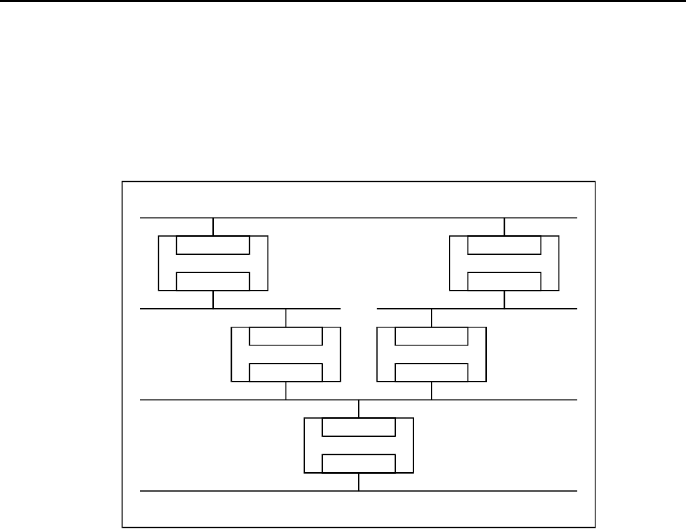
Spanning Tree Algorithms (STA)
FX-DS110-APL
42
Sample STA Application
This section describes examples of configurations in which network
loops occur, and how the application of an STA determines the
backup path.
LAN1
LAN2
LAN3
LAN4
LAN5
Priority
10
Priority
30
Priority
40
Priority
20
Priority
50
Port 1
Bridge 1
Port 2
Port 1
Bridge 5
Port 2
Port 1
Bridge 2
Port 2
Port 1
Bridge 4
Port 2
Port 1
Bridge 3
Port 2
Figure 6.1. Sample STA Application
All settings other than bridge priority settings are identical.
The root bridge is determined by the priority settings of each
bridge.
Root bridge Bridge 1
The designated bridge for each LAN segment is determined by
root path cost.
LAN1 Bridge 1
LAN2 Bridge 1
LAN3 Bridge 2
LAN4 Bridge 3
LAN5 Bridge 5

Spanning Tree Algorithms (STA)
FX-DS110-APL 43
The designated port for each bridge is determined by the
designated bridge.
Bridge 1 Ports 1, 2
Bridge 2 Port 2
Bridge 3 Port 2
Bridge 5 Port 2
The root port of each bridge is determined by its path cost to
the root bridge.
Bridge 2 Port 1
Bridge 3 Port 1
Bridge 4 Port 1
Bridge 5 Port 1
Ports that are neither designated ports nor root ports are
backup paths.
Backup path Bridge 4, port 2
After application of the STA, the network configuration looks like
this.
LAN1
LAN2
LAN3
LAN4
LAN5
Port 1
Bridge 1
Port 2
Port 1
Bridge 5
Port 2
Port 1
Bridge 2
Port 2
Port 1
Bridge 4
Port 2
Port 1
Bridge 3
Port 2
To blocking status
Figure 6.2. After STA Application
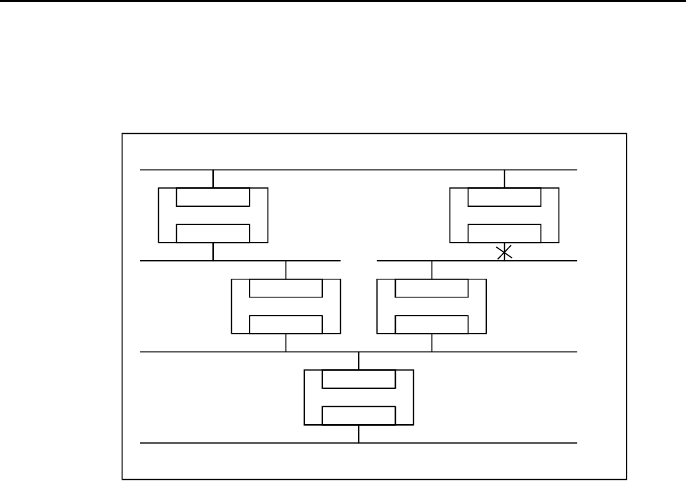
Spanning Tree Algorithms (STA)
FX-DS110-APL
44
After STA application, if a fault occurs at bridge 5 port, the STA
will be applied again to reconfigure the network topology. The
reconfigured network would then look like this.
LAN1
LAN2
LAN3
LAN4
LAN5
Port 1
Bridge 1
Port 2
Port 1
Bridge 5
Port 2
Port 1
Bridge 2
Port 2
Port 1
Bridge 4
Port 2
Port 1
Bridge 3
Port 2
To forwarding status
A fault occured
Figure 6.3. Reconfigured After STA Application

Spanning Tree Algorithms (STA)
FX-DS110-APL 45

SNMP Agent Functions
FX-DS110-APL
46
7. SNMP Agent Functions
This chapter describes the SNMP functions of this product, and
explains how they can be built in using the SNMP Manager SNMPc
by CONTEC.
SNMPc Overview
SNMPc is network control software for SNMP that runs on
Windows and controls all network devices that have SNMP agent
functions. SNMPc can be used to perform the following control
functions.
・ Monitoring unit startup status
・ Monitoring port operating status
・ Indicating MIB information
・ Displaying log files of traps, events, etc.
For instructions on installing and operating SNMPc, refer to the
SNMPc documentation. Note that a bitmap display of this product
can be displayed on SNMPc by installing it from the floppy disk
provided with this product.

SNMP Agent Functions
FX-DS110-APL 47
MIB Support
This product provides MIB support for MIB-II (RFC1213), bridge
MIB (RFC1493), and private MIB. Support is provided for the
following group names.
Table 7.1. Group Names
system Information related to AP, including AP control name,
operating time etc.
interfaces Basic information related to the physical interface layer,
including MAC address etc.
at Information corresponding to the ARP cache
ip Information related to IP protocol, including IP address
information etc.
icmp Information related to ICMP protocol, including ICMP
message TX/RX count, etc.
udp Information related to UDP protocol, including UDP
message TX/RX count, etc.
snmp Information related to SNMP, including SNMP message
count, etc.
dot1dBase Information related to bridge, including MAC address,
port count, etc.
dot1dStp Information rlated to spanning tree.
dot1dTp Information related to transparent bridges.
miscroapEnvironment Operating environment information.
microapStatusInfo Status information including LED, DIP switch status.
mistoapPriEthInterfaces Information related to wired side interface.
microapPriWLInterfaces Information related to wireless side interfaces.
mircoapPriWLLoginApInfo Information related to controlling AP.
miscroapPriWLNodeTable Wireless station information.
microapPriCamTable Information related to bridge.
Private MIB
MIB Group name Description
Bridge MIB
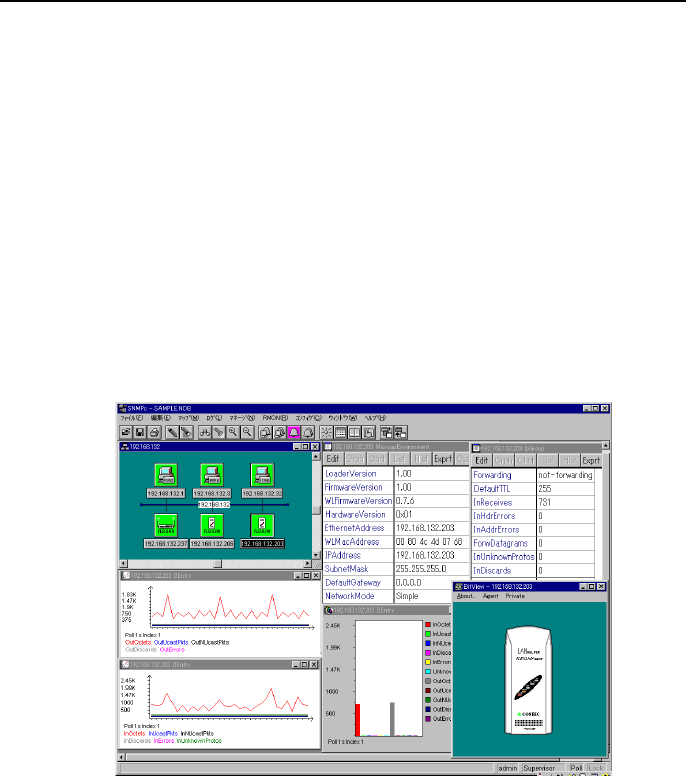
SNMP Agent Functions
FX-DS110-APL
48
Control Using SNMPc
Install SNMPc on a personal computer in the network to which this
product is connected. Read the SNBMPc manual carefully.
Once installation is complete, you can operate the PC on which
SNMPc is installed as a network manager, analyzing network status
and error information from this device as shown below.
Also, you can install the maintenance tools provided with this
product on SNMPc, to display information about this product in
graphic form as shown below.
Note! In order to control this product, its IP address and community name
must be entered accurately in the Settings.
Figure 7.1. Settings

SNMP Agent Functions
FX-DS110-APL 49
Building-in to SNMPc
Follow these steps to install SNMPc Ver. 4.
(1) Start the SNMPc Setup.program.
To start SNMPc Ver. 4, select [Start] – [SNMPc 4.0] – [Setup].
After startup, verify the user registration information.
(2) Insert the Maintenance Tools floppy disk provided with this
product into the floppy disk drive. Enter the floppy disk
drive path name followed by SNMPc.4\, and click 'OK.'
Example: If the floppy disk drive is the A: drive, enter
A:\SNMPc.4\.
(3) Select [CONTEC FX-DS110-APL], and click [OK] to start
installation.
(4) When the following message appears, click [No] to exit the
program.
[Do you want to install additional vendors?]
MIB Database Updates
After installing a new vendor, you will have to update the MIB
database the next time SNMPc is started.
Follow these steps to update the MIB database. In this description
we use 'SNMPc Ver.4' as an example.
(1) Start SNMPc.
To start SNMPc Ver. 4, select [Start] – [SNMPc 4.0] –
[SNMPc].
(2) Click [Yes] to update the MIB database.
(3) When you are finished updating the MIB database, click [OK].
The build-in to SNMPc is not complete.

Troubleshooting
FX-DS110-APL
50
8. Troubleshooting
This chapter describes common problems that may occur with this
product and what to do about them. If any problems occur that are
not described here, check to confirm that the re-occur, then contact
the store where you purchased the product, or the CONTEC
information center.
When Communication Fails
Check hardware
・ Check that the LAN cables are connected correctly.
Check software
・ The FLEXLAN-DS110 series is designed to handle a variety of
operating formats, and requires software setting for each type of
operation. Check that the settings are appropriate for the type of
operation, and check the format in which communication is being
attempted. Also check DIP switch settings.
・ The terminals that cannot communicate with each other may have
the same ESS ID. Two terminals with the same ESS ID cannot
communicate with each other.
・ Check that the APL IP address and subnet settings have been
entered.
・ Check that the operating mode setting has been correctly entered.
・ Check whether communication is restricted by security functions.
・ Check whether the data encryption setting is the same as that of
the recipient.
・ Check that the channel setting has been correctly entered.
・ Check that the communication speed setting has been correctly
entered.

Troubleshooting
FX-DS110-APL 51
Check the peripheral environment and place of installation
・ A nearby source of electromagnetic interference can prevent
communication. In general locations (excluding factories) the
following may be sources of electromagnetic emissions.
・ 2.4GHz band wireless networks not compatible with IEEE
802.11b.
・ Microwave ovens
・ Security gates
・ Copiers
・ Elevator motors
Most electromagnetic sources other than wireless networks are
local and not continuous, and therefore by moving the location of
the unit and waiting briefly, communication may be possible.
Also, do not place wireless devices too close together. A distance
of at least 1m should be allowed.
・ Sometimes communication is hindered by attenuation of electric
waves. Attenuation occurs naturally as distance from the source
of transmission increases, but may also be caused by objects in
the path of the transmission. The objects primarily responsible
for attenuation are the following.
・ Concrete walls
・ Metallic surfaces around antennas
Stable transmission at 11Mbps requires an RSSI value of at least 80.
The RSSI value can be verified on the Wireless Device Information
tab on the Status screen using the utility software.
When SNMP Connections Fail
・ It is possible that the device cannot locate a control parameter, or
that a private MIB has not been compiled. See Chapter 6.
・ If MIB settings have not been made, the correct community name
may not have been entered. Be sure the community name
setting agrees with the network manager's setting.
・ Check the SNMP settings that are being used.

Troubleshooting
FX-DS110-APL
52
When the APL Will Not Start
Check the power LED
・ Be sure the power LED is on. If it is not on, check the AC
adapter, be sure it is correctly plugged into an outlet, and that the
power supply type agrees with the power supply switch setting.
・ Check whether the power LED is flashing. If the power LED is
still flashing more than 10 minutes after the power is switched on,
the problem may be an APL firmware failure. Use the utility
software to upgrade the firmware version.

Troubleshooting
FX-DS110-APL 53

Appendix
FX-DS110-APL
54
9. Appendix
Product Specifications
Table 9.1. Physical Specifications
Wired LAN unit Ethernet standard IEEE 802.3
Data transmission speed 10Mbps
Access method CSMA/CD
Wireless LAN unit Transmission format IEEE 802.11b standard DS spectrum diffusion
Data transmission speed 11, 5.5, 2, 1Mbps(fixed/automatic)
Access method CSMA/CA + ACK(RTS/CTS)
Transmission packet IEEE 802.11b frame
Wireless category Low power data transmission system(2400-2497MHz)
Aerial power 10mW/MHz or less
Security Proprietary scramble/WEP(to be available)
Antenna Flat surface diversity antenna
Operating modes Ad hoc, Infrastructure/Station settings available
Dimensions (mm) 81(W) x 26.5(D) x 175(H)
Weight 0.2kg
Specification FX-DS110-APL
Table 9.2. Software Specifications
Protocols IP(RFC 791), ICMP(RFC 792), UDP(RFC 768),
ARP(RFC 826), SNMP(RFC 1157),
MIB II(RFC 1213)
Specification FX-DS110-APL
Table 9.3. Installation Environment Conditions
(Environment Specifications)
Supply voltage DC 5.5 to 7.0V(using AC adapter)
Current consumption 0.6A(Max.)
Operating temperature 0 to 50°C(main unit) 0 to 40°C(AC adapter)
Operating humidity 0 to 95%(no frost)
Airborne dust Not extreme
Corrosive gases None
Other Do not obstruct ventilation slits
Leave 5cm open space in all directions
Specification FX-DS110-APL
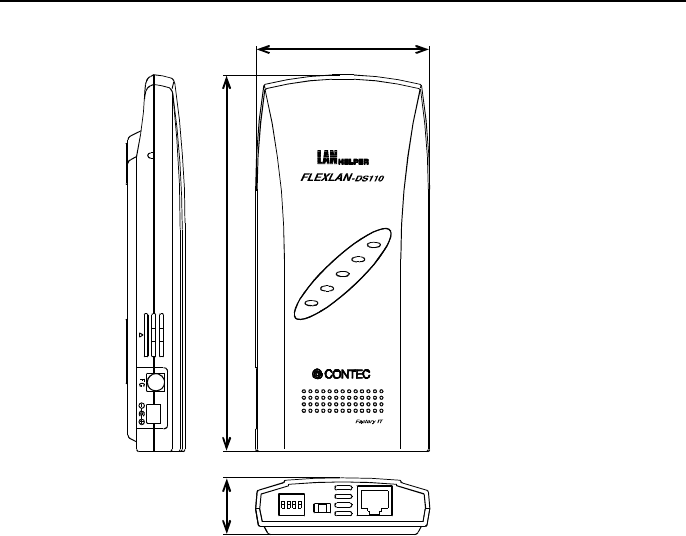
Appendix
FX-DS110-APL 55
DC/UTP UTP
POWER
WRX
WLINK
LINK
RX
81
175
26.5
[mm]
Figure 9.1. External Dimensions

Appendix
FX-DS110-APL
56
Input/Output Interface
UTP Port Pin Assignments
Table 9.4. UTP Port Pin Assignments
Pin no. Signal
1TD +
2TD _
3RD +
4Not used(VCC)*1
5Not used(GND)*1
6RD_
7Not used(VCC)*1
8Not used(GND)*1
*1 : These pin assignments are used when power is
supplied from 10BASE-T using POW-CB10.

Appendix
FX-DS110-APL 57
Glossary
IEEE (Institute of Electrical Electronics Engineers)
"I-triple-E," involved in a wide range of fields from
communications and computer to medicine and biology, with
primary activities related to publishing articles and sponsoring
conferences, but also recommending and setting of standards. The
organization sponsoring Committee 802, which is responsible for
LAN related matters.
IEEE 802.11/ IEEE 802.11b
The wireless LAN standard established by the IEEE.
MIB (Management Information Base)
The value of a MIB is determined by the Internet standard control
information structure.
SNMP (Simple Network Management Protocol)
A function necessary for network control, provides three functions:
Get (acquire), Set (modify), and Trap (notify event). Conceived as
an easily installable control protocol that places as little load on the
network as possible.
Diversity
A method of using multiple antennas, and selecting the one with the
best receiving conditions.
Router
A device for relaying between LAN's. The router determines data
addresses by the combination of a network address assigned to the
network and an individual computer address. Used particularly in
medium-scale and larter LAN systems with very large number of
clients, to reduce traffic (congestion) on communication lines.
Bridge
A device for relaying between LAN's. The bridge determines
whether to relay data based on the address of the computer to which
the data is being sent. It can be used to connect networks having
different protocols, or when data for broadcast to all computers is
received, can send this to all connected networks.

Appendix
FX-DS110-APL
58
LAN (Local Area Network)
A network configured from mutual connections between computers
within a limited area. Also called an "intranet" or "business or
regional data communications network."
RSSI (Receive Signal Strength Indication)
A numeric indicator of incoming signal strength.
Spectrum diffusion transmission
A method of transmission in which signals that are normally
transmitted over a given limited frequency band undergo narrow
band modulation (primary modulation), then again diffuse
modulation (secondary modulation) to intentionally diffuse the
signal over a broad frequency spectrum.
DS (Direct Sequence)
A type of spectrum diffusion signal using narrow band modulation
with phase modulation, in which the diffusion is by means of phase
modulation using a broad band diffusion signal (pseudo random
strings).
CSMA/CA (Carrier Sense Multiple Access with Collision
Avoidance)
CSMA is a method of avoiding collision by which wireless
terminals listen before transmitting and do not transmit if they can
year transmissions from other wireless terminals. CSMA/CA is
CSMA plus additional collision avoidance functions.
Hidden Terminal Problem
When wireless terminals are farther apart then their electric signals
can reach, or their signals are obstructed by objects, neither may be
able to receive the other's signals. Any two such wireless
terminals are said to be hidden from each other. In Ad Hoc mode,
because the carrier sense function is not effective between hidden
terminals there is a higher probability of collisions and throughput
(the volume of information sent in a given time interval) is reduced.

Appendix
FX-DS110-APL 59
RTS (Request to Send)
In communication via AP, transmission is controlled by CSMA/CA
plus RTS. In RTS, a wireless terminal asks the AP if it is all right to
transmit, and only transmits after an OK-to-send acknowledgement
signal is returned. This serves to avoid unnecessary collisions when
hidden terminals exist because hidden terminals cannot transmit.
Roaming
This term has the same meaning as roaming for a portable phone or
PHS. The AP is in the role commonly called the 'antenna/base
station' for the phone or PHS, and the user unit is in the role of the
phone itself.
Peer-To-Peer
A network in which two or more nodes can communicate directly
with each other without going through another device.
AP (Access Point)
In the FLEXLAN-DS110 series, access points serve as the bridge
between wired networks and wireless networks, as well as providing
bridge functions between segments and IP tunnel functions
indispensable to the building of versatile, large-scale networks.
User Unit
In the FLEXLAN-DS110 series, this refers to the FX-DS110-PCC
or a device with the FX-DS110-PCC built in.
ESS ID (Extended Service Set ID)
In the FLEXLAN DS110 series, the ESS ID is like a name assigned to
the wireless LAN network to which a unit belongs. The same name
must not be given to more than one wireless terminal. Conversely, a
wireless network can be partitioned by using different ESS ID names.
Channel
This term has the same meaning as a television or radio channel.
In the 2.400 to 2.497GHz band used by this product, the IEEE
802.11 standard provides for division into 14 channels numbered 1
to 14. Even on the same network, wireless devices operating on
different channels cannot communicate with each other.

Index
FX-DS110-APL
60
10. Index
C
Component Locations, 7
F
Features, 1
H
Handling Precautions, 3
I
Introduction, 1
L
Liability, 3
O
Obtain Service, 3
Overview, 7
S
Setup, 17
W
Warranty, 2
A-46-500
LZV6181
[010509]